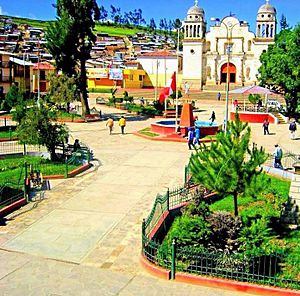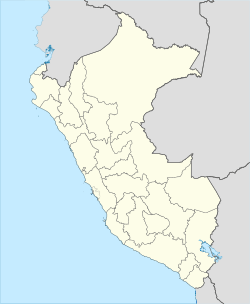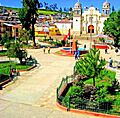Coracora facts for kids
Quick facts for kids
Coracora
Qura Qura
|
|
|---|---|
|
Town
|
|
 |
|
| Nickname(s):
Coracora Tierra de Tradiciónes
|
|
| Country | |
| Region | Ayacucho |
| Province | Parinacochas |
| District | Coracora |
| Elevation | 3,175 m (10,417 ft) |
| Time zone | UTC-5 (PET) |
Coracora (also called Qura Qura) is a lively town located in the heart of Peru. It's the main city of the Parinacochas Province in the Ayacucho Region. About 13,000 people call Coracora home.
Contents
What's in a Name?
The name Coracora (or Qura Qura) comes from the Quechuan language. The word qura means 'herbaceous plant' (like a green, leafy plant). When the syllable is repeated, it means there's a big group or collection of these plants. So, Coracora means 'a place with lots of herbaceous plants'!
Where is Coracora?
Coracora is about 800 kilometers (500 miles) away from Lima, the capital of Peru. It sits high up in the mountains, between 3,150 and 3,350 meters (about 10,335 to 11,000 feet) above sea level. This area is known as the Quechua ecological region, which means it's a high mountain zone with a specific climate and plants.
Coracora is the main city of the Parinacochas Province. This province is part of the Ayacucho department in southwestern Peru. The districts that make up the Parinacochas Province include Coracora, Upahuacho, Pacapauza, Rivacayco, Chumpi, Incuyo, Pullo, and Anizo.
Coracora's Climate
Coracora has two main seasons. The winter, from June to September, often brings cold nights and frost. The summer, from December to March, is warm and very rainy.
| Climate data for Coracora, elevation 3,149 m (10,331 ft), (1991–2020) | |||||||||||||
|---|---|---|---|---|---|---|---|---|---|---|---|---|---|
| Month | Jan | Feb | Mar | Apr | May | Jun | Jul | Aug | Sep | Oct | Nov | Dec | Year |
| Mean daily maximum °C (°F) | 18.2 (64.8) |
17.6 (63.7) |
17.6 (63.7) |
18.6 (65.5) |
18.9 (66.0) |
18.9 (66.0) |
18.7 (65.7) |
19.3 (66.7) |
19.9 (67.8) |
20.0 (68.0) |
19.8 (67.6) |
19.3 (66.7) |
18.9 (66.0) |
| Mean daily minimum °C (°F) | 7.0 (44.6) |
7.2 (45.0) |
6.9 (44.4) |
5.9 (42.6) |
4.4 (39.9) |
4.0 (39.2) |
3.7 (38.7) |
4.3 (39.7) |
5.0 (41.0) |
5.4 (41.7) |
5.5 (41.9) |
6.5 (43.7) |
5.5 (41.9) |
| Average precipitation mm (inches) | 111.5 (4.39) |
136.6 (5.38) |
94.4 (3.72) |
24.3 (0.96) |
1.4 (0.06) |
0.4 (0.02) |
2.0 (0.08) |
2.0 (0.08) |
3.4 (0.13) |
5.0 (0.20) |
6.6 (0.26) |
28.7 (1.13) |
416.3 (16.41) |
| Source: National Meteorology and Hydrology Service of Peru | |||||||||||||
Coracora's History
Spanish explorers founded Coracora in the 1600s. It grew along the important road that connected Lima and Cusco. Many old buildings, like the beautiful local church, were built in the Baroque style using white ashlar stone.
In the 1800s and 1900s, Coracora became a successful mountain city. This was thanks to its strong cattle ranching industry. By the 1940s, Coracora was doing very well, both culturally and economically. This was quite special for a small city in the mountains of Peru.
However, in the 1980s, the town faced challenges due to social unrest in Peru. Today, Coracora has bounced back! It's once again a busy center for ranching, trade, and tourism. The roads, buildings, and services have improved a lot.
Fun Festivities: La Virgen de Las Nieves
Every year, from August 1st to August 8th, Coracora celebrates a big festival called La Virgen de Las Nieves, which means "Virgin of the Snow." It's a very important tradition for the town.
Festival Highlights
- August 1st: People get ready for the celebrations. Families cook special food for everyone to enjoy.
- August 2nd: People walk to Pumahuiri, a mountain where the Virgin of the Snow was found. They sing and dance along the way, often singing prayers.
- August 3rd: This day is called "Entrada de Negritos" (Entrance of the Blacks). Children lead a parade into town, singing and dancing, with people following them.
- August 4th: It's the "Entrada de Chamiza" (Entrance of retama). People bring in bundles of these plants on donkeys and llamas. At night, they burn the dry plants and dance around the fires to live music that plays all night long. There are also "Los Castillos," which are fireworks displays on wooden structures in the main plaza, Plaza de Armas. People also enjoy serenades with dancing and singing.
- August 5th: This is the main day of the festival. Townspeople gather and walk around the main plaza, where the church is located.
- August 6th to August 8th: The city goes to the bullring. Each family pays for their own spot to watch. People buy bulls to honor Our Lady of the Snows. This is like a special donation. If a bull doesn't get hurt, the person who bought it and the person receiving it can enter the bullring. People dressed in red lead a team of bulls.
Each year, a different person or family takes on the important role of organizing the main festival day on August 5th.
The Story of the Virgin of the Snow
Long ago, Spanish travelers were taking a statue of the Virgin Mary from Lima to Cuzco. They stopped to rest at a very long and tiring mountain called Pumawiri. One man had a dream that the Virgin of the Snow appeared to him. She told him that she wanted to stay in Coracora, not go all the way to Cuzco.
When the man woke up, he told his friends about his dream. They believed him! So, they went down the mountain and brought the Virgin statue to Coracora, where she has been honored ever since.
Famous People from Coracora
- Abraham Falcon, a skilled craftsman who makes musical instruments, especially stringed ones like guitars.
Images for kids
See Also
 In Spanish: Coracora para niños
In Spanish: Coracora para niños



